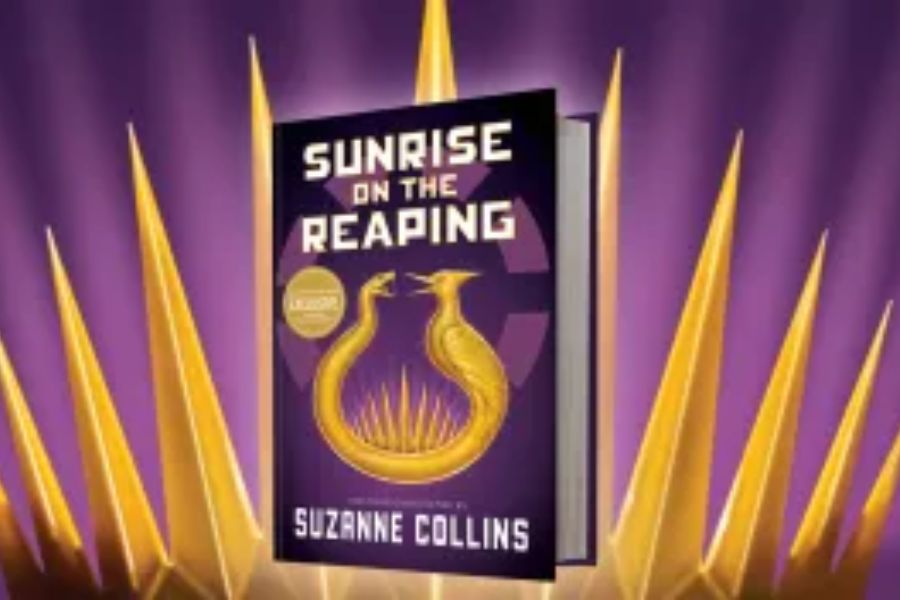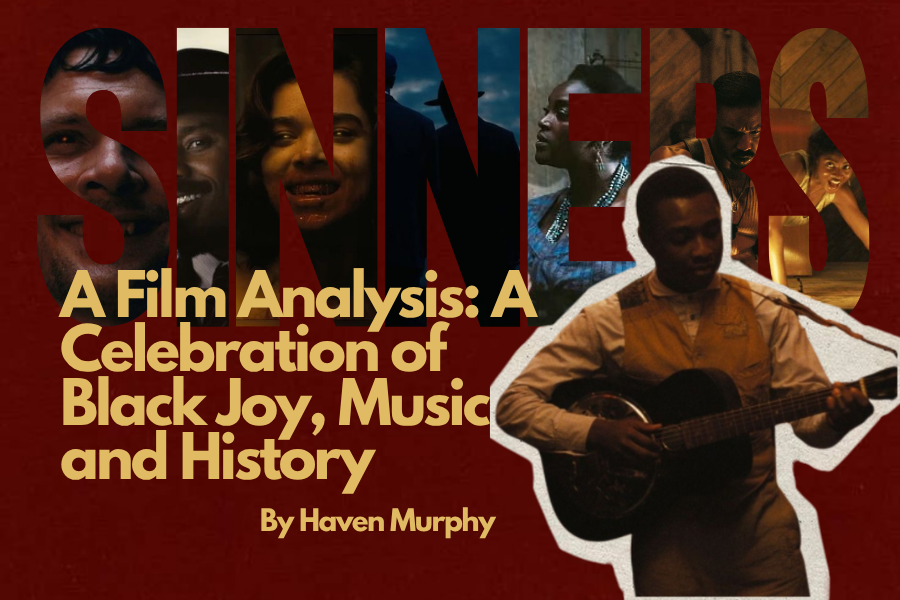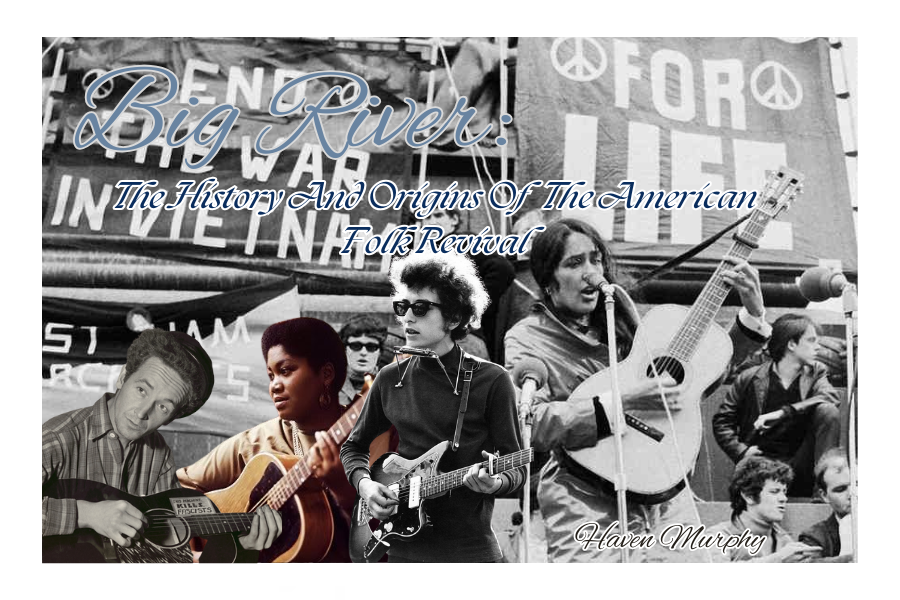Sunrise on the Reaping, a prequel to the popular Hunger Games series, tells the story of Haymitch Abernathy, Katniss’s mentor during the 74th Hunger Games. There is lots of excitement and anticipation for both this book and the movie that it is based on, which premiers in theaters Nov. 2026. Sunrise on the Reaping is another highly entertaining, yet thought-provoking installation to the Hunger Games trilogy that also serves as the missing link between the previous prequel, The Ballad of Songbirds and Snakes and the original trilogy. The entire book is teeming with dramatic irony and foreshadowing. It seems like every few sentences of the first chapter contain references to the other books. Please note that this review may contain spoilers.
First off, many avid fans may need to recap due to the fact that the original novel was written more than ten years ago. Movie fans may also be curious about details in the books that relate to Haymitch’s story that were not present in the original novel. In the first novel, Haymitch Abernathy is the mentor to the protagonist, Katniss Everdeen, as she competes in the deadly Hunger Games, a yearly tradition in Panem in which two kids from each district are sent to fight to the death. In this novel, author Suzanne Collins portrays Haymitch as sarcastic, drunk and lonely.
Sunrise on the Reaping has the most connections to Catching Fire which makes sense considering that both novels are about Quarter Quells, special Hunger Games occurring every 25 years in which the rules are changed, making the games even more deadly. In Catching Fire, when Katniss is reaped for the 75th Hunger Games she is made to compete against former victors of other Hunger Games, so she decides to watch the videos from previous years to see what she is up against. While doing so, she comes across clips from Haymitch’s Hunger Games, the 50th Quarter Quell in which twice as many tributes were reaped from each district. To make things worse, the arena, while mesmerizingly bright and beautiful, was extremely deadly, with everything in it being extremely poisonous. As the games progressed, Haymitch joined up with another girl from District 12, Maysilee, and the two made a deadly combo. An interesting detail about Maysilee is that exclusively in the novel Katniss receives her iconic mockingjay pin from Madge, Maysilee’s niece who is also the mayor’s daughter. Additionally, here, Katniss also discovers that Maysilee and her twin were best friends with Katniss’s mother. In the actual arena Katniss teams up with former victors, Mags Finnick, Beetee, Wiress and Johanna. The team escapes from the arena with the help of Haymitch, Effie, Plutarch, President Coin and District 13.
Sunrise on the Reaping is a compelling and intricate novel that I would recommend to any fan of dystopian fiction, YA novels, or that are interested in politics and power struggles. Each character is written compellingly and intricately. In general, across all of the series, Collins writes characters that are so complex that they feel tangible, and expertly avoids stereotypes which is particularly poignant when it comes to her female characters. An example of this is Lenore Dove. Despite her limited appearances in the novel, Collins finds a way to make her an interesting character that makes her own autonomous choices instead of reducing her to a bland love interest. The main character, Haymitch’s personality has glimpses to the plotting, sarcastic mentor that he will become, however, in this novel, Collins also gives him devastating hope and innocence. An especially hilarious, yet at the same time gloomy, detail that Collins adds to his character is the alcohol motif that is associated with him. In Sunrise on the Reaping, Haymitch is a bootlegger and even makes that part of his personality for the Games in order to win sponsors. Irony of ironies however, is that in the original trilogies, Haymitch is an extreme alcoholic, but in this novel he declines drinking alcohol several times, claiming that he never cared for it. While hilarious, this motif is reflective of the loss of innocence that Haymitch will undergo during the games which will turn him into an alcoholic.
For some, the plot of the novel may seem redundant since Collins already has two novels about a character going into the Hunger Games arena, especially since fans already know that Haymitch survives. However, Collins adds a spin to this story by instead of pitting Haymitch against his fellow tributes, Haymitch’s main conflict is against the gamemakers and the arena itself. In actuality, Haymitch does not really seem to play the Hunger Games in this novel, but instead focuses on his own secret task of destroying the arena. Additionally, Collins adds further layers to the plot by tying in themes of propaganda and asking her readers to consider what is real and what is not. Fans may think that they know exactly what happens to Haymitch from reading the other novels, however, in these prior novels, fans only hear about the Capital broadcasts of his Hunger Games. Collins therefore shows how the Capital manipulates the real events to show only a story that fits their agenda. This major theme thus makes room for plot twists that readers will not expect.
In general, throughout the novel, Collins makes thoughtful emotional connections to the major themes of her novel. A major idea of her novel is implicit submission. Specifically, she looks at the ridiculousness of the many allowing the few to control them. The first character to bring up this idea is Lenore Dove, who connects this idea to the title “Sunrise on the reaping.” She wonders why Haymitch assumes that there will always be a reaping day on his birthday just like the sun always rises. Like in her other novels, Collins also introduces compelling songs whose lyrics compliment the novel’s themes and emotional moments. The most prevalent is that she uses “The Raven” by Edgar Allen Poe to highlight the tragedy of the relationship between Lenore (whose name comes from this poem) and Haymitch. Altogether, her fast-paced writing style keeps up well throughout the book and with her other novels.
While I thoroughly gasped in delight every time there was another cameo or connection to another book in the series, there were so many connections that it almost seemed unbelievable. Especially when it comes to the characters introduced in Catching Fire that all make an appearance in Sunrise on the Reaping. Mags, Beetee, Wiress and Plutarch, all aid Haymitch in his quest to break the arena and all of them fail. This is interesting considering that all of these characters attempt the same thing with Katniss in Catching Fire and succeed. Although thematically showing how successful rebellions are built upon former failure, it does seem slightly unbelievable that all of these tributes were randomly reaped in the 75th Hunger Games (another Quarter Quell)…unless they weren’t randomly reaped. My personal theory on this is that since Snow rigged the 75th Hunger Games to get rid of Katniss, he probably additionally rigged it to get rid of any other victor who had caused trouble in the past which would include those who were previously caught trying to rebel during Haymitch’s games.
A movie adaptation has already been announced to be released next November. Francis Lawrence has been confirmed to return to the franchise as the director. Casting is still unknown. According to Business Insider, while initial stages of the movie are in place, producers have been trying to avoid any work that might potentially leak spoilers about the book since it was so recently released.
Sunrise on the Reaping is a great addition to the Hunger Games franchise. Fans should definitely look forward to reading this one. To any non-fans, I would definitely recommend reading the entire series.









